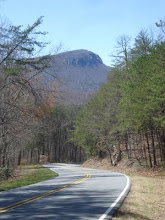Below is another reason that the park is such a special place. From the Winston Salem Journal:
Philip Dickinson
SPECIAL TO THE JOURNAL
Published: September 4, 2009
Hanging Rock State Park is one of the most beautiful parks in North Carolina. It has rocky peaks, panoramic views, five waterfalls, a lake for swimming, a river for canoeing and miles of hiking trails. Covering nearly 7,000 unspoiled acres, it also is a great place to see birds. And it's just 45 minutes north of downtown Winston-Salem in Stokes County.
And the world's fastest creature lives at the park.
Peregrine falcons have been clocked at speeds approaching 275 miles an hour when they dive after prey. Forty years ago, these magnificent birds were almost extinct in the United States because of DDT poisoning. Like the bald eagle, they have rebounded and are no longer considered endangered. Hanging Rock is one of the few known breeding sites in North Carolina. For this reason, the park has been nominated as an Audubon Important Bird Area (IBA).
A favorite place to nest
Falcons have been nesting on Moore's Wall at Hanging Rock since 2000. Toby Gordon helps monitor activity at the cliff. He said that inaccessibility makes it impossible to know how many young have successfully fledged over the years, but nestlings were heard in 2008. This year the male arrived in the spring without a female. The life of a bird, even a falcon, is a perilous one. Maybe next year our resident male will return with a new mate.
Seeing a falcon takes luck and some work. You can scan the skies around Moore's Knob, perhaps from the Tory's Den section of the park. Alternatively, you can hike the strenuous 4.2-mile Moore's Wall Loop Trail up to the knob and back. Even though chances of a falcon sighting are slim, the knob offers a spectacular view of the countryside and a likely encounter with resident ravens. Ranger Jamie Anderson said, "this is one of my favorite areas to go birding because of the variety of habitats." In September, look for migrating, broad-winged hawks and other raptors.
Hanging Rock is also home to some of our most colorful birds, like the crimson-and-black scarlet tanager, the deep-blue indigo bunting and an assortment of wood warblers. Walk along any of the wooded trails in the park in May and you can hear the "teacher-teacher" of the ovenbird, the rising trill of the northern parula and the loud weet-weeteo of the hooded warbler. Black-and-white warblers creep along tree limbs, and American redstarts fan their orange-and-black tails. In the summer, you can even find species that escape the heat of Forsyth County, like black-throated blue, black-throated green and worm-eating warbler.
When you get to the park, stop at the visitor's center for a trail map and a bird checklist. About 165 species have been documented at the park, and that number will likely grow. The Audubon Society of Forsyth County has adopted the park under the IBA program and has started conducting Christmas and spring counts. The park also has binoculars and basic field guides for children to borrow.
The Hanging Rock Trail is the most popular walk at the park. Hooded warblers and ovenbirds frequent the lower section. As you climb steadily, listen for the wood thrush's flute-like song and watch for woodpeckers, chickadees -- perhaps even an Acadian flycatcher or tanager. Near the summit, look for more warblers, vultures and ravens. Jaye McClure, another park ranger, echoes my enjoyment of watching ravens perform their aerial acrobatics.
If you have more time, explore Indian Creek as it winds down the mountain past Window Falls all the way to the Dan River. The lush habitat probably offers the greatest variety of birds in the park, including common yellowthroats, water thrushes, gnatcatchers and vireos.
Warning: The entire trail is 3.7 miles one way. For shorter excursions, try the lake area or Lower Cascades Falls, another of Anderson's favorite bird spots.
■ The annual Pilot Mountain Hawk Watch is from Sept. 12 to 30. Come look for migrating, broad-winged hawks and maybe even an eagle. To enlist as a counter, contact me at 659-2464 or pdickins@gmail.com. Also, on September 12 the Audubon Saturday bird walk is at Historic Bethabara Park. Meet behind the Visitor's Center at 8 a.m. For more information, contact Susan Jones, 768-9151 or sljones@triad.rr.com.
■ The Bird's-Eye View column will be published on the first and third Saturday of each month beginning Sept. 19.
■ Bird's-Eye View is a joint column by Ron Morris and Phil Dickinson. Today's column was written by Dickinson. Dickinson is a legal writer. He has been an active birder for 15 years and is a past president of the Audubon Society of Forsyth County and chairs the conservation committee. Morris retired after 24 years as curator at the N.C. Zoo. He has studied birds around the world and is the vice president of the Audubon Society of Forsyth County. If you have a birding question or story idea, write to Bird's-Eye View in care of Features, Winston-Salem Journal, P.O. Box 3159, Winston-Salem, N.C. 27101-3159, or send an e-mail to birding@wsjournal.com. Please type "birds" in the subject line.
Truffles NC Keeps on Keeping on!!
7 years ago

No comments:
Post a Comment